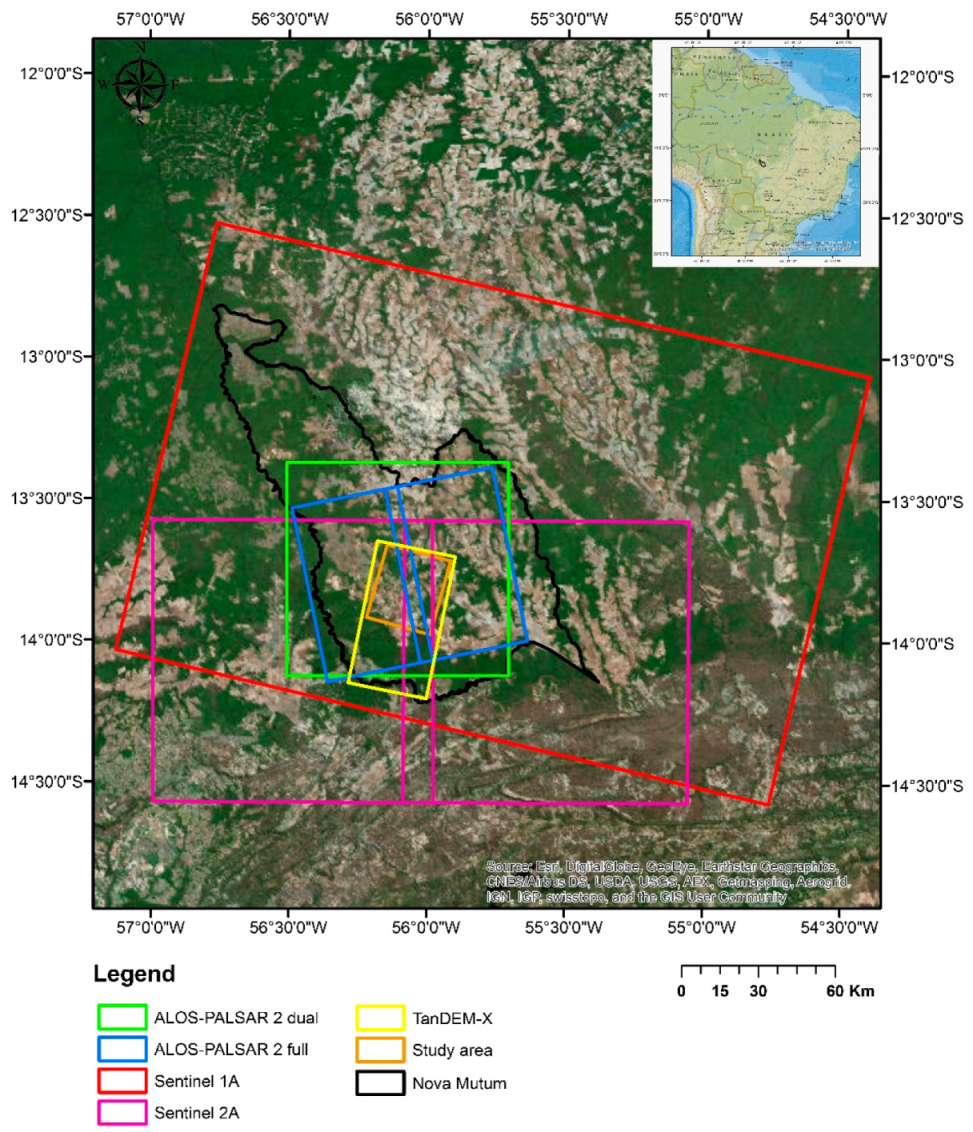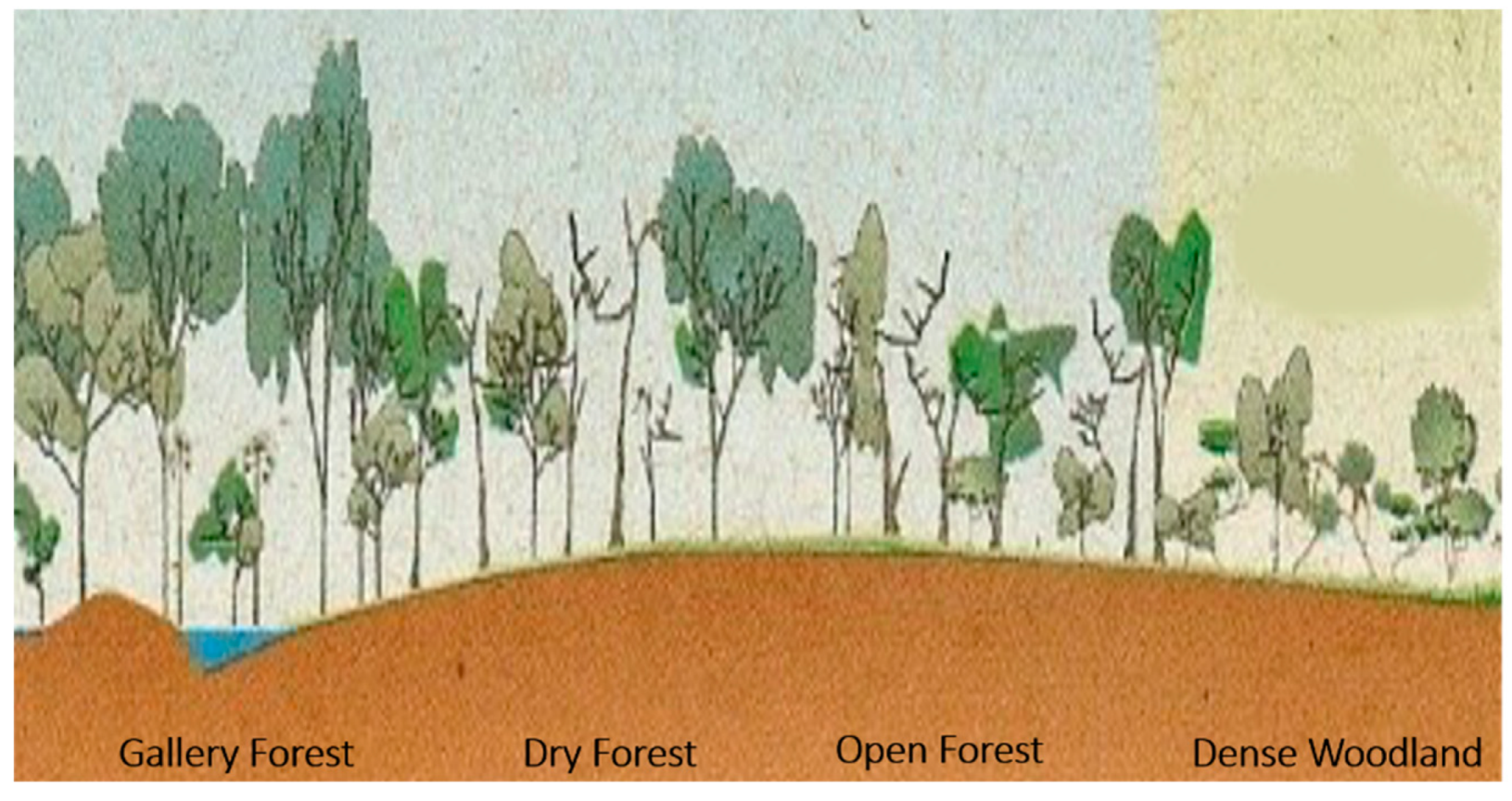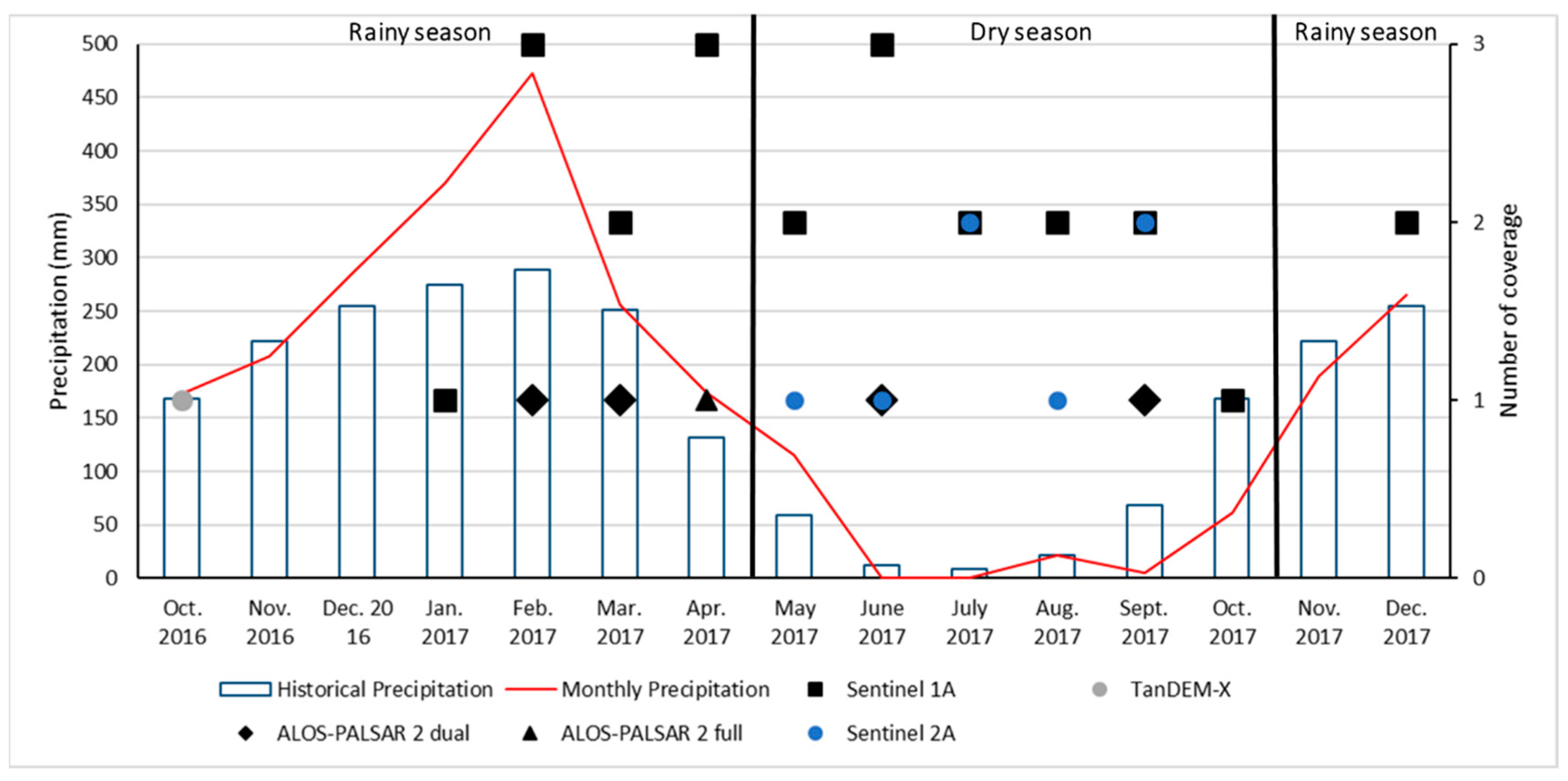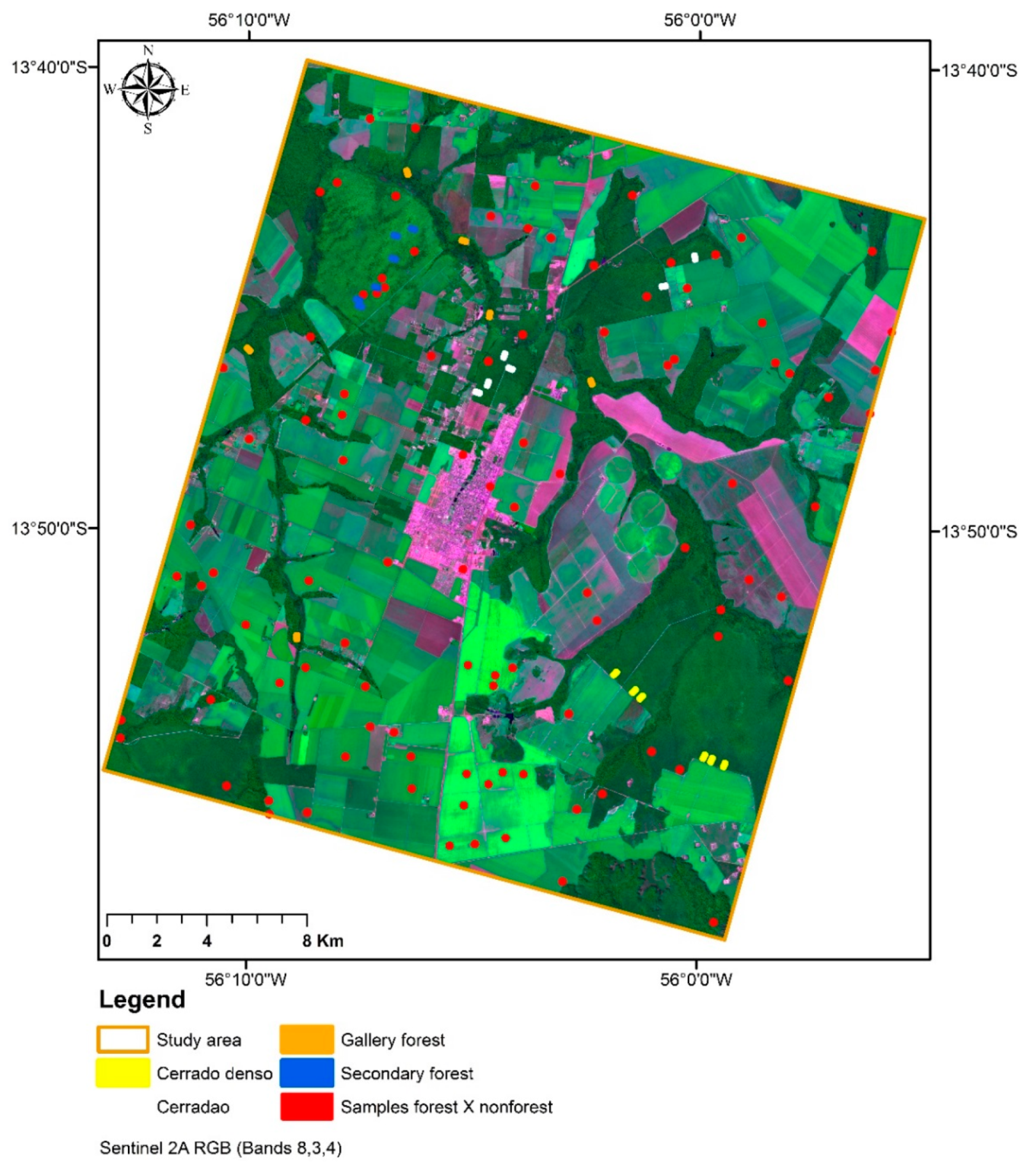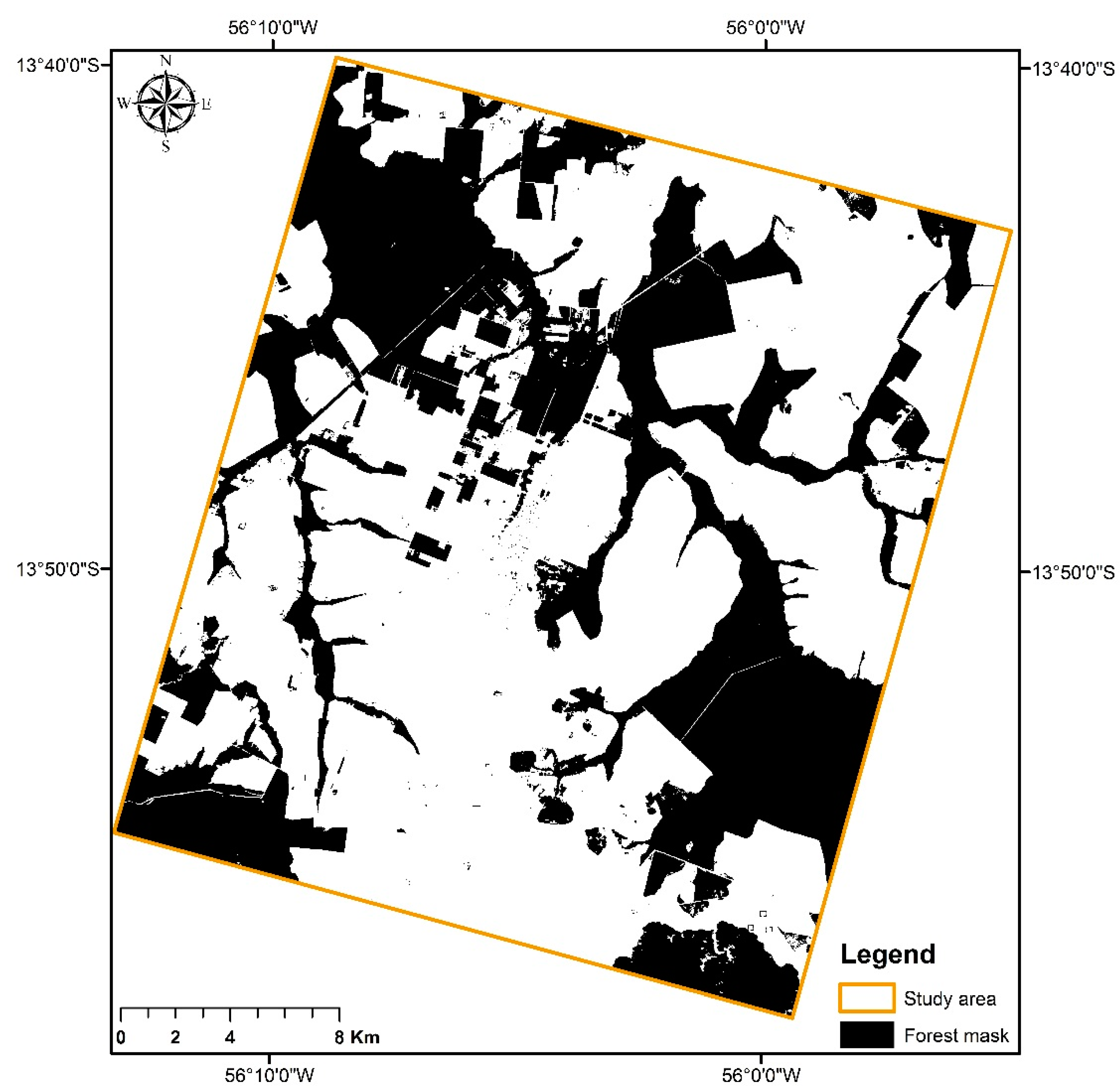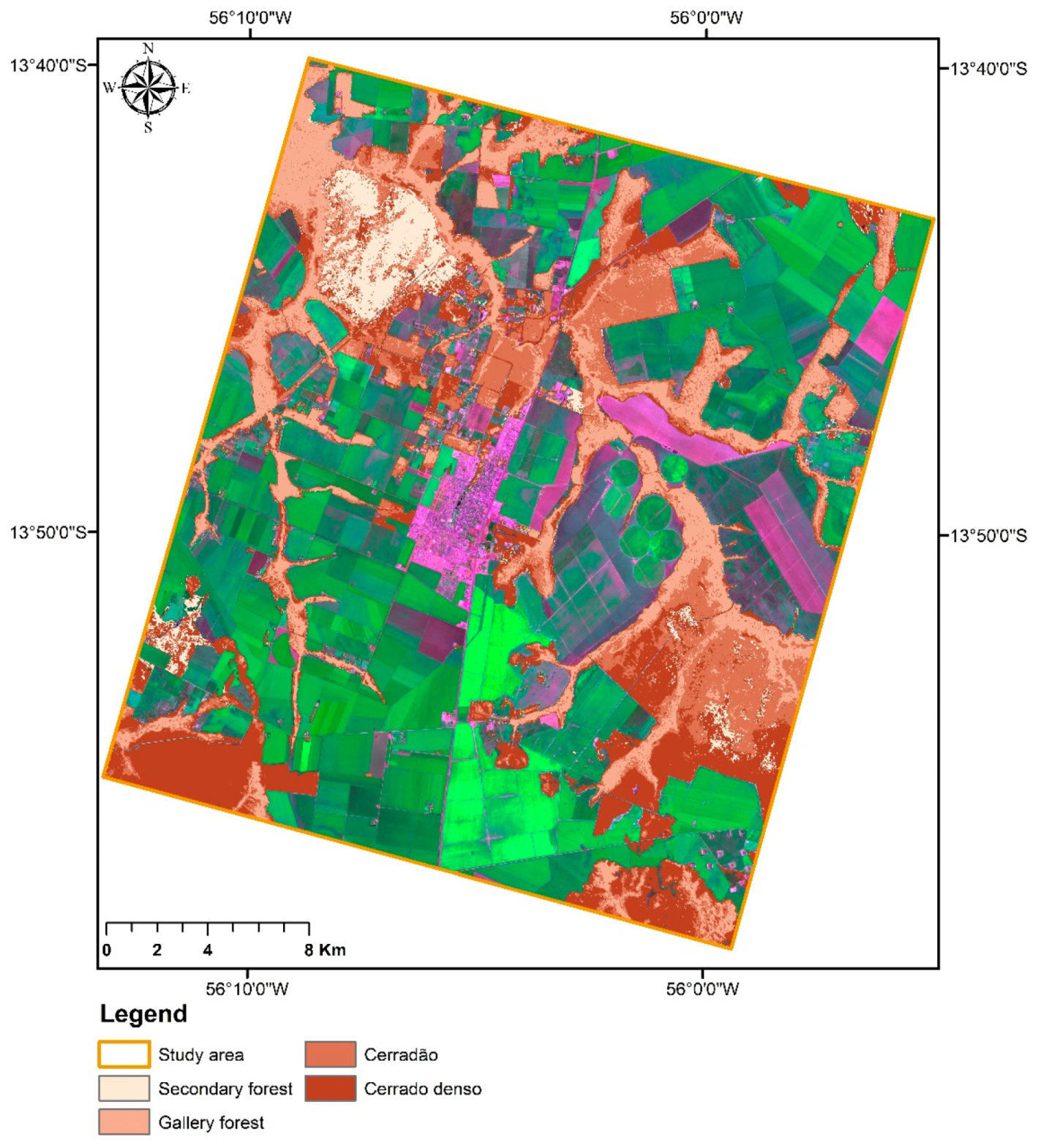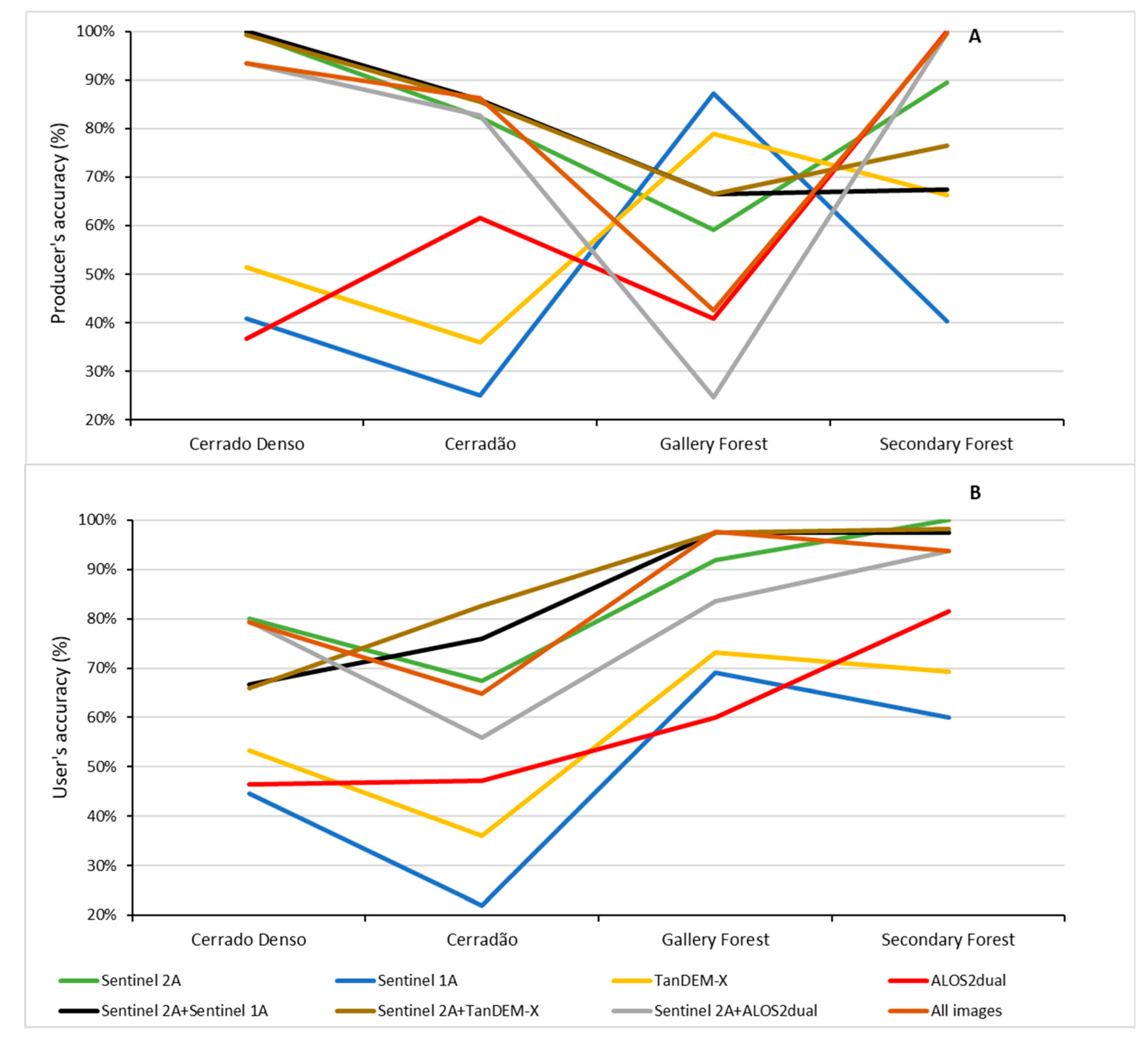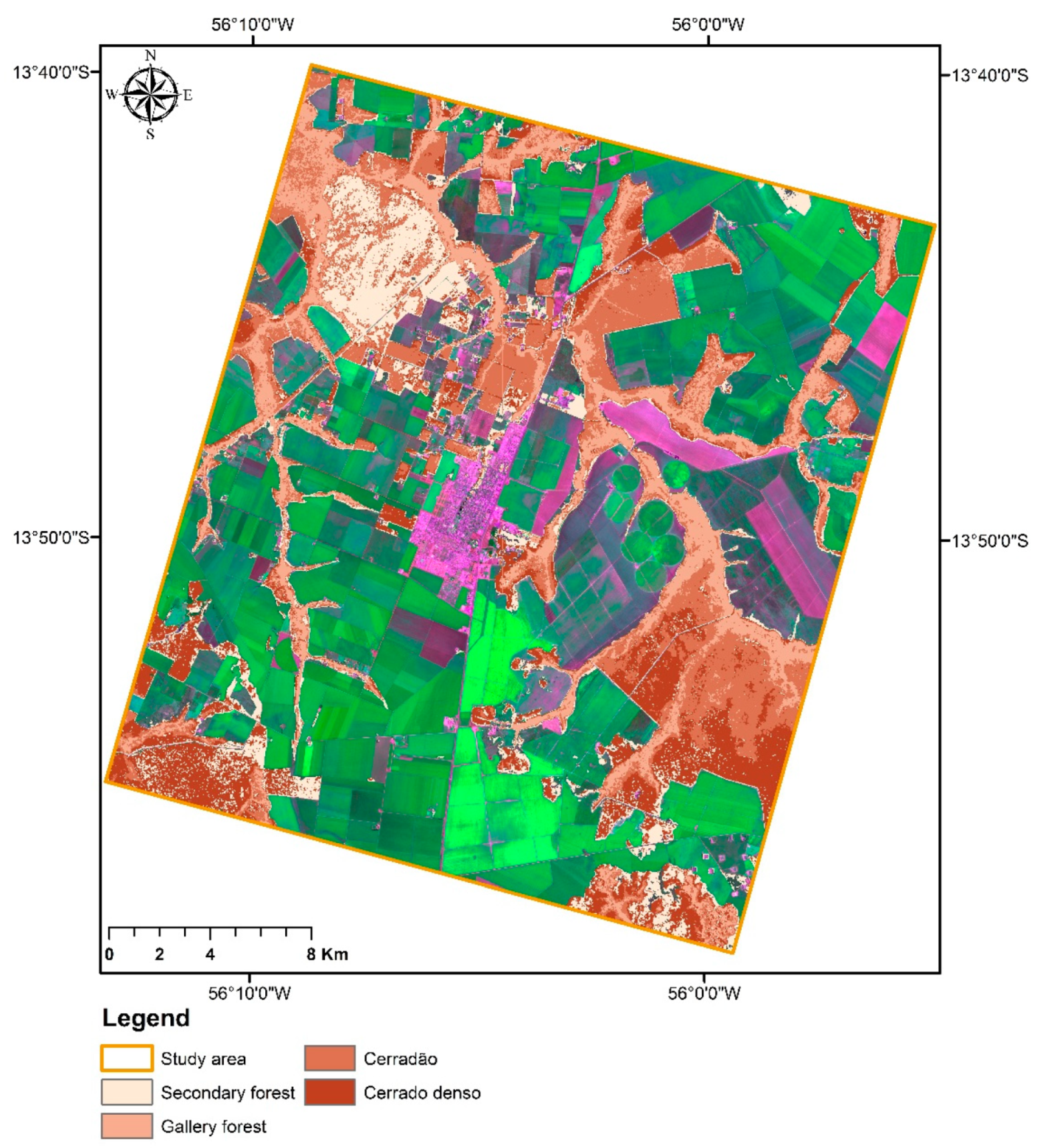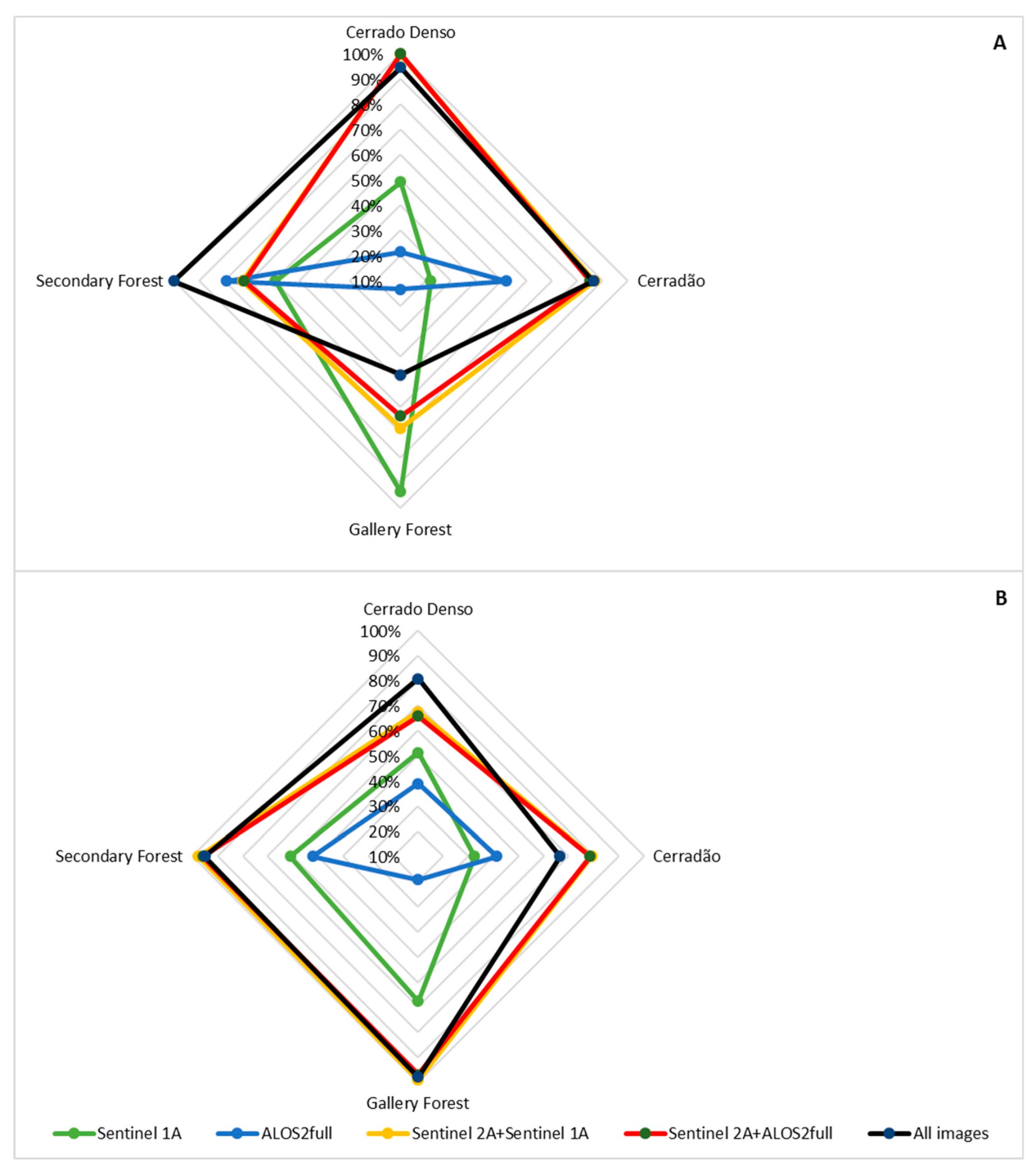1. Introduction
The Cerrado biome is considered as being among the most extensive and diverse ecosystems in the Neotropics and is a hotspot in the context of biodiversity [
1]. It is also one of the most threatened ecosystems in South America, with over 40% of the biome converted to agriculture and the remainder highly fragmented [
2]. Despite the threat to the Brazilian Cerrado, studies on this ecosystem are few and recent.
The Cerrado biome is the second largest complex vegetation present in Brazil and occupies about 200 million hectares, of which the largest territory is in the state of Mato Grosso [
3]. This large distribution of the Cerrado biome in Brazil covers three main vegetation types: grassland, savannas, and forest formations, which results in indeterminate boundary and a gradient of biomass, height, and tree cover. This large variance in different types of vegetation in the Cerrado is responsible for the high biodiversity in this biome. The three areas of biodiversity in Cerrado, the South–Southeast, Central Plateau, and Northeast areas are mainly separated by the altitude and latitude [
4]. The heterogeneity of the vegetation types is also seen in the microclimate variability and in different types of soils, e.g., mostly latosol, red-yellow latosol, red latosol, quartz-neosols, and argisols [
5,
6,
7]. In addition, the amount of biomass and carbon storage is differently distributed in the biome, depending on the vegetation type and soil [
8,
9,
10]. This large biodiversity and floristic heterogeneity in Cerrado was and is decreasing due to deforestation since the 1980s, which can lead to a loss or decrease in ecosystem services [
11].
Cerrado is the most deforested biome in Brazil due to the high agricultural impact, particularly caused by the world market-oriented production of soy, cotton, and sugarcane. Deforestation is facilitated by its flat topography, easy management of the soil for agricultural activities, and high mechanization [
12]. For pasture and agricultural activities, Cerrado has become a more viable alternative to the Amazon despite its poor soil quality. Despite a lack of consistent deforestation records, a few studies have looked at rates of deforestation in the Cerrado biome. Machado et al. [
13] analyzed the deforestation rates from two different sources. They found that from 1985 to 1993, Cerrado lost 1.5% of its total vegetation area annually. From 1993 to 2002, the rate of deforestation per year decreased to 0.67%. Starting from 2002, several Brazilians institutes, such as the Instituto Brasileiro do Meio Ambiente e dos Recursos Naturais Renováveis (IBAMA) and National Institute for Space Research (INPE), started to monitor the rate of deforestation in the Cerrado biome. From 2002 to 2017, Cerrado lost around 0.8% of its total vegetation area per year. The ease of deforesting in the Cerrado biome created a hotspot region for deforestation at the boundary with Amazon biomes.
Current regulation and restrictions in ecosystem preservation have driven deforestation and cover changes into the forest–savanna transition zone, as in West Africa [
14] and South America [
15]. Janssen at al. [
14] projected an increase of tree cover losses from 20 to 85% in Ghana. In South America, the transitional zone is known as “arc of the deforestation” (AOD). The AOD is located in the frontier states of Mato Grosso, Pará, and Rondônia, and it accounts for 85% of the areas that were deforested between 1996 to 2005 [
16,
17]. In these transition areas, the laws that support the protection of forests are even weaker and unmanaged. One example is the environmental legislation that defines the amount of natural vegetation that has to be preserved (80% in the Amazon, 20% in the Cerrado biome) [
18]. Additionally, this forest–savanna boundary comprises a mixture of floristic characteristics from both adjacent regions, which increases the complexity in mapping the ecotone between the Amazon and Cerrado. Marques et al. [
19] showed that the official boundary between Cerrado and Amazon conducted by the Brazilian Institute of Geography and Statistics (IBGE) is not accurate, and in some areas, the length of the transition zone was miscalculated by 245.5%. This problem is likely to misinterpret the mapping of land use and consequently decrease the accuracy of vegetation classification. Moreover, the problem of low accuracy in the mapping of the boundary between Cerrado and Amazon affects the calculation of wood density, and therefore biomass estimation as well [
20]. To overcome these problems, Brazil needs to improve the monitoring system of deforestation and land use change (LUC), especially for the Cerrado biome.
The field monitoring of Cerrado is a time-consuming challenge, given the large size of the biome. Hence, the use of remote sensing facilitates the monitoring of the status and changes in land cover and land use at large scales. Most studies with remote sensing to monitor the differentiation of the vegetation types in Cerrado use optical sensors, mainly in the savanna and grassland formations where there is low signal saturation. These studies mostly use the Normalized Difference Vegetation Index (NDVI) [
21,
22,
23], Spectral Linear Mixture Model (SLMM) [
24,
25], and phenological profiles [
26]. Additionally, Müller et al. [
27] demonstrated the challenges in mapping land use in Cerrado, essentially a result of its high diversity. The study showed a considerable uncertainty in the classification of cropland and pastures areas. The same problem was reported by Sano et al. [
28], whose study reports a spectral similarity between cropland, pasture, and natural savanna vegetation, which can increase the uncertainty when mapping. Moreover, Ministry of the Environment (MMA) [
29] mapped the land use in the whole Cerrado biome and the study showed that one of the biggest challenges for this area was to map the different types of vegetation, due to the strong seasonality of natural vegetation. However, the optical sensors can extract the information from the canopy, but arboreal vegetation types have differences in vertical structure and tree cover, so that with optical sensors, uncertainties in the identification of forest savanna vegetation types increase. Additionally, optical images are affected by weather conditions (cloud cover).
Radar sensors have an important advantage compared to optical sensors: the ability of radiation to penetrate through cloud cover and considerable parts of the canopy of trees/forest stands due to the higher wavelengths compared to optical sensors. Thus, the resulting radar signals (amplitude/backscatter and, if available, coherence) provide information that can be used to describe the vertical structure of vegetation stands. This information can be used to better estimate forest structure variables such as canopy cover, tree density, tree height or others, as well as to stratify vegetation (e.g., different types of forest). The longer the wavelength, the deeper radar Bands penetrate dense vegetation, which increases its sensibility to perceive the differences that improve discrimination of vegetation types. Almeida-Filho and Shimabukuro [
30] demonstrated that the L Band from the JERS-1 synthetic-aperture radar (SAR) can be used to detect cover changes in forested and non-forested areas in the Cerrado biome. Evans and Costa [
31] also mapped six vegetation habitats in Brazil using L and C Bands using the backscattering information from the surface. In the same country, Saatchi et al. [
32] mapped five land cover types using the JERS-1 mosaic, using texture measurement. Santos et al. [
33], Sano et al. [
34], and Mesquita et al. [
35] had satisfactory results using radar images to discriminate the vegetation types in the Cerrado biome, especially with the L Band. The sensitivity of the radar sensor to perceive the differences in vegetation structures makes it useful for mapping different types of forests.
The savanna vegetation has one of the largest forest diversities. In this case, the combination of different satellite images (optical and radar) and spatial resolution (low, medium, and high) may help to improve the quality of satellite based monitoring concepts [
32]. However, there is little information about how the synergy of different data can contribute to map forest vegetation types in Cerrado. Yet, the free availability and the development of new optical and radar sensors, such as Sentinel 2A, Sentinel 1A (both free) or ALOS2 and TanDEM-X, are increasing the use of both sensors (radar and optical) for vegetation mapping. Recent studies have shown that the synergy of radar and optical images improved vegetation type discrimination, especially in the Cerrado biome, where the greenness seasonality had a huge influence during the year [
36,
37,
38].
The aforementioned studies concentrate on parts of Cerrado where the vegetation cover is mostly homogeneous and that are not located in transitional areas such as the the Arc of Deforestation. However, most of the deforestation and expansion of agricultural and pasture areas are concentrated in this region. Additionally, these regions have a mixture of vegetation type and species from Cerrado and Amazon, which makes the study in this area more complex. The few studies in this area are related to the land use and not the mapping of vegetation type, as in Zaiatz et al. [
39], who evaluated the spatial and temporal dynamics of land use and cover of the Upper Teles Pires River Basin from 1986 to 2014. In order to overcome the lack of studies using both sensors to discriminate vegetation types, the aim of this study is to evaluate the use of optical and radar remote sensing for mapping the different types of vegetation in the transitional area between the Cerrado and Amazon biomes.
4. Discussion
The results showed the importance of integrating satellite images from different sensors to classify the forest and non-forest area. The Program for the Estimation of Amazon Deforestation (PRODES) is the most important project that has been conducting satellite monitoring of deforestation in the Legal Amazon, producing annual deforestation rates in the region, using Landsat images (30 m spatial resolution). Comparing the data of forest areas from the PRODES project with the results of our work, it is possible to verify a high underestimation in the forest areas, mainly in the classes gallery forest and cerrado denso. The PRODES estimated an area of 12,702 ha of forest, and our work estimated an area of 27,326 ha. This difference can be associated to the different spatial resolution used in PRODES (30 m) and in our study (10 m).
Optical images are largely used to map vegetation types in the Cerrado biome. In our results, S2 classifications showed the highest overall accuracy and kappa values. The application of S2 images to map vegetation types in the Cerrado biome is new. In general, Landsat is the most common sensor used to discriminate vegetation types in the Cerrado. Nascimento and Sano [
23] had 85% overall accuracy for mapping vegetation types in this biome. The authors used Landsat 7 ETM+ images to discriminate the Rupestrian Cerrado (Savanna formation) in the Chapada dos Veadeiros National Park in Goias State, which can be difficult due to the spectral confusion with other types of Cerrado vegetation. The optical bands located in the red and NIR wavelengths showed high importance and contribution to the discrimination of vegetation type, as was visible in our results (
Table 3 and
Table 4). Nascimento and Sano (2010) [
23] agree on the importance of VIS and NIR regions for characterizing forest areas, as the vegetation has higher reflectance in this wavelength range and is thus more sensitive. Additionally, the number of optical images in ours and other studies helps the increase of discrimination power of different vegetation types, due to the unique spectral signatures of the plant during the year [
64,
65]. The optical data are certainly useful to map the vegetation type in Cerrado; however, these images are usually not available during the rainy season and the optical data cannot extract information from the structure of the forest [
66]. Moreover, the availability of images in the rainy season would allow for a higher temporal resolution, which is crucial to better discriminate the vegetation types in the Cerrado biome due its high seasonality. Additionally, in dense areas of vegetation, the optical sensor is usually saturated due to the low optical depth penetration through these areas, affecting the mapping of the various vegetation types. There are important projects assessing the land use of the Cerrado biome, such as the TerraClass Cerrado project, which produced a map of the land use of the Cerrado biome. However, the project had great difficulties to discriminate the different types of vegetation, which is important for the preservation of biodiversity in this region. Nevertheless, TerraClass presents another step in the challenge of mapping the different types of vegetation in the Cerrado [
29].
The use of radar images can be a solution to overcome the lack of image availability in the rainy season and the high saturation of optical images in areas of great biomass density. In our radar, classification results from the dry and rainy seasons, TanDEM-X (X Band) and ALOS-PALSAR 2 (L Band) dual polarimetric classification from the dry season showed the highest overall accuracy and kappa values. The influence of vegetation scattering mechanism dependencies is strongly dependent on the wavelength and polarization of the sensor. In the short/intermediate wavelengths, such as X and C Bands, backscattering represents the radiation interaction of canopy, leaves, branches, secondary branches, and part of volumetric scattering (inside crown). Longer wavelengths, such as the L and P Bands, have the capability for deeper penetration. Bigger vegetation components such as trunks, crown, ground, and branches interact with these lower wavelengths. According to the results for the dry season, L Band dual polarimetric images had the highest overall accuracy and kappa values were comparable to the classifications that used single sensor (X and C Bands). The study area is mostly forested. In these areas, radar signals are more likely to be saturated in the X and C Bands compared to the L Bands [
67]. The polarization controls the types of components that interact with the radiation. In our study, the L Band cross-polarized HV polarization was the most important variable that contributed to the random classifier in the best classification. This agrees with the fact that cross-polarized images have direct relation with volumetric scattering, and are therefore sensitive to forest structure [
68]. There are few studies in the Cerrado biome using only radar images. Sano et al. [
34] used the L Band from JERS-1 SAR data to map the different types of vegetation by analyzing the backscattering coefficient values. The study could well separate the grassland, mixed grass/shrub/woodland, and woodland in the state of Distrito Federal.
The results of the CI 95% OAA showed the importance of the fusion between optical and radar data to map vegetation type in the Cerrado biome, since the confidence interval with the narrowest range belonged to the classification that used all images from the dry and rainy seasons, where the narrower the interval, the more accurate the classification. The Cerrado vegetation has one of the largest forest diversities, consequently the combination of different sensors (optical and radar) and spatial resolution (low, medium, and high) results in a great improvement in the accuracy [
32]. Of the three classifications that obtained the highest values of accuracy and kappa, two used radar and optical images. This showed the importance of the integration of different sensors in improving the mapping of forest types in Cerrado. A similar result was reported by Sano et al. [
38], who combined optical and radar images to improve the classification of different vegetation types in the Cerrado biome. The study had a high overall classification accuracy, which used both sensors in regions of savanna and grasslands formations. Sano et al. [
38] used data from the dry and rainy seasons and showed the importance of the time series in improving the classification of different types of vegetation. Additionally, Sano et al. [
38] showed better performance of radar data (JERS-1 SAR) compared to optical data (Landsat). In contrast, our results showed that optical data performed better for classification, compared to the radar data. However, this study used a higher number of radar images using L Band compared to our study, which increased the efficiency of mapping vegetation, due to the sensitivity to identify the various structures of the forest, consequently better distinguishing the type of forest, as reported by Lucas et al. [
69], Garestier [
70], and Santoro [
71]. Carvalho et al. [
37] used images from ALOS-PALSAR and Landsat to map the different types of vegetation and the results agree on our findings. The highest overall accuracy and kappa values were from the S2 classification; therefore, in our results, the use of radar images did not reach the highest accuracy and kappa values. Carvalho et al. [
37] showed that the use of radar data did not improve classification accuracy; however, the study used only one data from radar imaging. Concerning GLCM textures, the same study showed similar results. Grey Level Co-occurrence Matrix textures images had a high variable importance during the Random Forest classification, in particular for entropy, which showed the disorder of GLCM elements. This may be related to the differences in the backscattering of the vegetation type classes.
Regarding the user’s accuracy, the secondary forest was better classified using optical images, whereas the other three classes were better classified using optical and radar images. The optical bands were the most important variables for the RF classifier. The texture images were the second most important ones. Several authors presented similar results achieved in this study [
62,
72,
73]. All mentioned studies showed an improvement in the separability of land cover types employing texture images. The coherence image from TanDEM-X was the third most important variable. Schlund et al. [
72] and Baron and Erasmi [
62] showed an improvement in the discrimination of forest against other classes using coherence as well.
Other studies about classification of vegetation type in the Cerrado biome, such as Mesquita et al. [
35], were in regions where the vegetation has a smaller gradient compared to regions within the Arc of Deforestation, such as Distrito Federal, Minas Gerais, and São Paulo. The IBGE and the MMA mapped vegetation types from the whole Cerrado biome. The studies used Landsat images from the year 2004 and scaling of 1:250,000, which is not enough to detect the gradients of the Cerrado biome. The mapping of vegetation types in transition zones is still a challenge, due to these not having a clear border [
74]. However, these regions play an important role in the conservation of the Amazon and Cerrado biome, wherein 75% of the deforestation in Amazon occurs.
5. Conclusions
In this paper, we evaluated the use of optical and radar remote sensing for mapping different types of vegetation in the transitional area between the Cerrado and Amazon biomes. The method described in this study improved the mapping of vegetation type in the Arc of Deforestation in the Cerrado biome and can be applied to create accurate vegetation type maps. We evaluated the use of four different sensors, one optical sensor (Sentinel 2) and three radar sensors (Sentinel 1, ALOS, TanDEM-X), for better vegetation type identification and area discrimination, so that these can be used for better calculations of biomass loss and carbon storage in the high dynamic Arc of Deforestation in Brazil.
When applying a supervised random forest classification, the highest overall accuracy and kappa coefficient were obtained using only the Sentinel 2A for classification. However, of the three classifications that obtained the highest overall accuracy and kappa values, two used radar and optical images. Bands 5, 11, and 12 of Sentinel 2A, texture images from Sentinel 1A cross-polarization, and coherence of TanDEM-X were the most important images in order to separate each class, as calculated by the random forest variable importance. The combination of optical and radar sensor data usually improves the vegetation classification. Nevertheless, in our study, the single use of optical sensors was sufficient to discriminate the four forest classes in the study area: cerradão (Open Forest), cerrado denso (Dense Woodland), gallery forest, and secondary forest classes in a highly fragmented complex vegetation biome. Such information is relevant for the upcoming mapping of vegetation types in the endangered Cerrado/Amazon ecotone.
